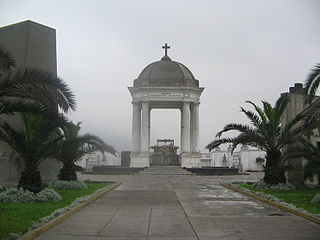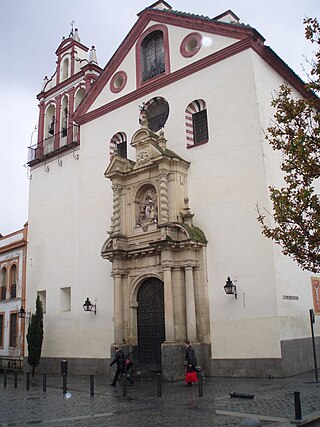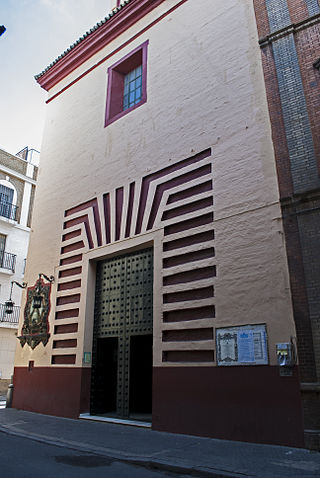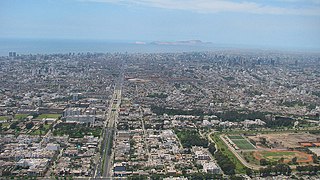
The Historic Centre of Lima is the historic city centre of the city of Lima, the capital of Peru. Located in the city's districts of Lima and Rímac, both in the Rímac Valley, it consists of two areas: the first is the Monumental Zone established by the Peruvian government in 1972, and the second one—contained within the first one—is the World Heritage Site established by UNESCO in 1988, whose buildings are marked with the organisation's black-and-white shield.

Arcos de la Frontera is a town and municipality in the Sierra de Cádiz comarca, province of Cádiz, in Andalusia, Spain. It is located on the northern, western and southern banks of the Guadalete river, which flows around three sides of the city under towering vertical cliffs, to Jerez and on to the Bay of Cádiz. The town commands a fine vista atop a sandstone ridge, from which the peak of San Cristóbal and the Guadalete Valley can be seen. The town gained its name by being the frontier of Spain's 13th-century battle with the Moors.

Presbyter Matías Maestro Cemetery, formerly the General Cemetery of Lima, is a cemetery, museum and historical monument located in the Barrios Altos neighbourhood of Lima District, in Lima, Peru. Inaugurated on May 31, 1808, it was the first pantheon in the city since burials were previously held in the city's churches. It was named in honour of its designer, Spanish priest Matías Maestro.

Friar José Camilo Henríquez González was a priest, author, politician, and is considered an intellectual antecedent to and founding father of the Republic of Chile for his passionate leadership and influential writings. He was also one of the most important early South American newspaper writers and wrote several essays, most notably the Proclama de Quirino Lemachez, which promoted Chilean independence and liberty. He also wrote under the pseudonym Quirino Lemachez.

Barrios Altos is a Peruvian neighbourhood that forms the eastern part of Lima District, part of the historic centre of the city. It owes its name to the fact that, topographically, it is higher than the rest of the old part of the City, due to the elevation of the land that exists towards the Andes mountain range, which is evident in its streets to this day.

The Basilica and Convent of Saint Peter, formerly known as Basilica of Saint Paul after the school of the same name, is a Catholic church located in the historic centre of Lima, Peru.

The Basilica and Priory of Nuestra Señora de la Merced is a Roman Catholic church located in Lima, Peru. It was designed in the Baroque style known as Churrigueresque. The church was built under the supervision of Friar Miguel de Orenes in 1535. The Blessed Virgin Mary of Mercy, the patroness of the Peruvian Armed Forces, is venerated in the Basilica. The Mercedarians, who evangelized the region, helped to develop Lima by building many of the churches preserved today.

San Juan y Todos los Santos, also known as Iglesia de la Trinidad, is a Catholic church located on the Plaza de la Trinidad in Córdoba, Spain. It stands on the site of the former Convento de la Trinidad established shortly after Fernando III conquered the city in 1236. Built in the Baroque style, it forms part of the Historic centre of Córdoba, a UNESCO World Heritage site.

The Basilica and Maximus Convent of Nuestra Señora del Rosario, popularly known as the Convent of Santo Domingo, is a Catholic religious complex located in the city of Lima, Peru.

Carlos Gustavo Castillo Mattasoglio is Peruvian prelate of the Catholic Church whom Pope Francis named Archbishop of Lima on 25 January 2019. From completing his extensive training in theology in 1987 until his episcopal appointment, he devoted himself to both pastoral care and theological education in Peru.

St. Buenaventura's Church is situated in the calle Carlos Cañal in the Casco Antiguo of Seville, Andalusia, Spain. It was the church of the Franciscan College of San Buenaventura that was destroyed in the 19th century.

Leonardo Jaramillo was a Spanish mannerist painter, active in the 17th-century in the Viceroyalty of Peru.

The Catacombs of Lima are underground ossuaries in the historic centre of Lima, Peru. The catacombs were built under the Basilica and Convent of San Francisco and currently function as a museum.

The Convent of Our Lady of the Angels, commonly known as the Iglesia y Convento de los Descalzos, is a Franciscan convent in Rímac District, Lima, Peru. It was declared a cultural heritage of Peru in 1972.

The Trinitarian Church of Lima is a Catholic church and monastery in the colonial area of the neighbourhood of Barrios Altos in Lima, Peru. Located in the corner of Áncash and Paruro streets, it was built in a baroque and neoclassical style in 1722.

The Church and Convent of Our Lady of Peñafrancia, better known as St. Clare's Monastery, is a Catholic church, convent and monastery belonging to the Capuchin Poor Clares located in the neighbourhood of Barrios Altos, part of the historic centre of Lima, Peru.

The Church and Monastery of Saint Catherine of Siena is a Catholic church and monastery located between Andahuaylas, Puno and Inambari streets in the neighbourhood of Barrios Altos, part of the historic centre of Lima, Peru. It is located next to the Fort of Santa Catalina, built two centuries later and named after the convent.

The Church of Our Lady of the Forsaken and of Saint Joseph, known commonly as the Church of the Forsaken, is a Catholic church located between Venezuela Avenue and the Jirón Recuay of the main square of Breña, in Lima, Peru.

The Church of Saint Anne is a Catholic church that forms part of the historic centre of Lima, Peru. It is located in Barrios Altos, next to Italy Square, and is one of two main candidates for the location of Rímac, the Indian oracle that gave the local river—and thus the city—its name. For this reason, the site receives the name of Huaca de Santa Ana.

Chacarilla del Estanque, also known simply as Chacarilla, is a neighbourhood located in the districts of San Borja and Santiago de Surco, in Lima, Peru. An upper class area of both districts, it is located south of the Headquarters of the Peruvian Army and known for its commercial sector, most notably its shopping centre.





















